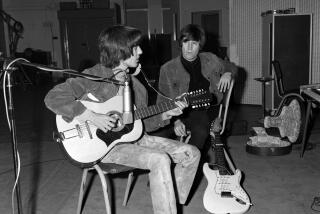Jukebox Man Lights Up Those Old Music Makers
SAN FRANCISCO — Daniel Zavaro has dedicated his adult life to the resurrection of musical memories.
Zavaro has restored or repaired 5,000 jukeboxes, a nostalgic vocation that has taken him across the world and brought joy to his hands and sweet music to his ears.
“I’m not really after money,” said Zavaro, who charges $20 an hour for his restoration work. “I like it. I’m very happy when I see that there will be 5,000 more jukeboxes in the world and that they will not be destroyed.”
Zavaro, 52, arrived in San Francisco in 1976 and set up a one-room shop in the Mission District, an ethnic, blue-collar neighborhood dotted with auto repair shops.
There are no signs to help anyone locate his San Francisco Music & Games Co. He depends on word-of-mouth recommendations and advertisements in an industry newsletter for his business.
But it seems to work. He currently has a two-month backlog of work.
Inside his parts-cluttered shop, Belgian-born Zavaro shows off his current project, a 1946-48 AMI Model A jukebox known as “The Mother of Pearl.”
Built After World War II
The 6-foot jukebox--encircled by blue and red plastic and encrusted with a vertical row of multicolored jewels--was the first model built with plastic after World War II.
“To tell you the truth, this is the first time that I’ve restored a Model A,” Zavaro said.
It’s a safe bet there are few other jukebox models Zavaro has not restored since he entered the business 30 years ago in Brussels.
It was 1958 and Zavaro had just come out of the Belgian army as a radio repairman. He was in line for a job with IBM but was told he’d have to wait anywhere from three to six months to begin work.
Zavaro had to think about feeding his wife and child, so he took what he believed was a temporary job with a Wurlitzer jukebox distributor in Brussels.
“I loved it. I just loved it,” said Zavaro, a slim, bespectacled man who lives at the back of his shop.
Zavaro, trained as an electronic technician in the Army, was at the right place at the right time, as the Seeburg company had produced the first electronic jukebox in 1957, eclipsing mechanical machines.
Three months after taking the job, Zavaro was made the chief technician for the Wurlitzer distributor.
After his divorce in 1964, Zavaro embarked on a four-year journey across the world while continuing to work on old jukeboxes. He lived in Montreal for a while before coming to San Francisco.
Zavaro says the most popular jukebox ever is the 1946-1947 Wurlitzer 1015--about 60,000 were made--though his favorite is the 1962 Seeburg DS100.
“Maybe it’s not the best-looking, but it’s most reliable, the best machine--almost perfect,” he said.
Jukeboxes and the classic rock ‘n’ roll they recall have become popular again in the United States, but foreign interest in the old machines has been unparalleled, said Zavaro, who often gets customers from Japan and Australia knocking at his door.
“The world has discovered the value of an antique jukebox,” he said. “They are discovering the nostalgia of that time.”
Last year, for example, a Wurlitzer 1100 jukebox would probably sell for about $5,000 in the United States, $10,000 in Paris and $15,000 in Switzerland. The 1948-1949 model, of which about 16,200 were made, retailed new for about $1,100.
Some of the old machines can increase in value by 50% over a three-year period, he said.
And there’s another advantage to owning or restoring a jukebox, because besides its investment value, “it’s one that people enjoy,” he said.
There’s plenty of opportunity for jukebox investment--and enjoyment--this holiday season because of the 50,000 that jukeboxes Zavaro estimates are scattered throughout the San Francisco Bay Area.
Zavaro also repairs other machines, such as pinball games. But his primary work--and enjoyment--has come from jukeboxes.
“There’s a kind of good feeling,” he said, “a feeling that I never had to exploit people to make a living.”
More to Read
Inside the business of entertainment
The Wide Shot brings you news, analysis and insights on everything from streaming wars to production — and what it all means for the future.
You may occasionally receive promotional content from the Los Angeles Times.









